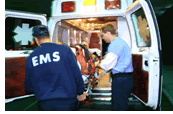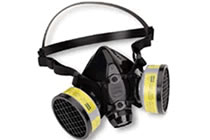- Home
- Public Employees Occupational Safety and Health
- PEOSH Health Standards
- PEOSH Respiratory Protection Standard (29 CFR 1910.134)
PEOSH Respiratory Protection Standard (29 CFR 1910.134)
An estimated 5 million workers are required to wear respirators in 1.3 million workplaces throughout the United States. Respirators protect workers against:
- Insufficient oxygen environments
- Harmful dusts, fogs, smokes, mists, gases, vapors, and sprays
- Airborne infectious agents
These hazards may cause cancer, lung impairment, other diseases, or death.
Respirators must be used when airborne hazards are present and effective engineering controls are not feasible. Respirators have their limitations and are not a substitute for effective engineering controls. Where respirators are required to protect worker health, public employers must comply with the PEOSH Respiratory Protection Standard (29 CFR 1910.134).
The Standard contains requirements for:
- Program administration
- Worksite-specific procedures
- Respirator selection
- Employee training
- Fit-testing
- Medical evaluation
- Respirator use, cleaning, storage, maintenance and repair
Some public sector occupations where respirators are commonly required include:
- Firefighting
- Emergency medical services
- Hazardous waste operations and emergency response
- Law enforcement special operations
PEOSH adopted the federal OSHA Respiratory Protection Standard by reference along with other General Industry Standards effective December 12, 2004.
The text of the PEOSH Respiratory Protection Standard resides on the federal OSHA web site.
PEOSH also uses the official “interpretations” about the Respiratory Protection Standard which have been developed by federal OSHA in response to questions from employers and employees.
- PEOSH Model Fire Department Written Respiratory Protection Program: [doc 373k] [pdf 831k]
- Replacement Self Contained Breathing Apparatus Cylinders: [pdf 57k]
- Forms
| Name of Form |
| Firefighter Respirator Fit Test Record (OCC-30) |
| SCBA Respirator After Use/Daily Inspection Form (OCC-33) |
| Firefighter Respirator Medical Evaluation Questionnaire (OCC-24) |
- PEOSH Respiratory Protection Model Program for Law Enforcement - A Template for Local Law Enforcement Written Programs (including forms) [doc 274k]
 Protecting Emergency Medical Services Workers from Airborne Infectious Diseases: A Step-by-Step Guide and Model Respiratory Protection Program for Using N-95, N-99 and N-100 Disposable Particulate Respirators
Protecting Emergency Medical Services Workers from Airborne Infectious Diseases: A Step-by-Step Guide and Model Respiratory Protection Program for Using N-95, N-99 and N-100 Disposable Particulate Respirators
- Forms
| Name of Form |
| Documentation of Attendance at Respiratory Protection Training (OCC-22) |
| Documentation of Medical Evaluation for Respirator Use (OCC-25) |
| Fit-test Record (OCC-32) |
| Respiratory Protection Program Evaluation (OCC-16) |
| Respirator Medical Evaluation Questionnaire (OCC-23) |


